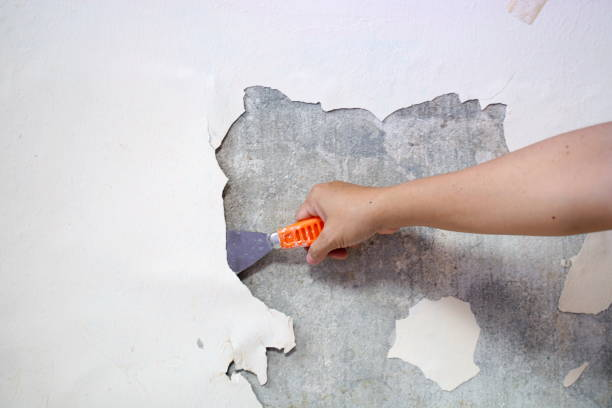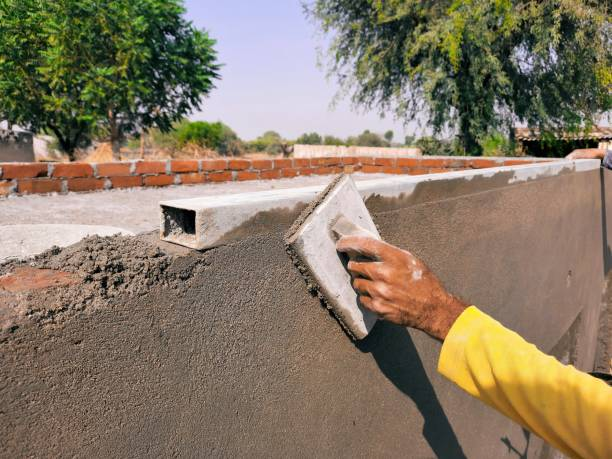In the realm of construction, the question echoes: Can rendering be removed? Unveiling the layers of external rendering, this exploration delves into the intricacies of cement render removal and offers insights into the imperative query of how to remove rendering.
External rendering is pivotal in buildings’ aesthetic appeal and structural integrity. As we navigate through the various aspects of rendering removal, from its feasibility and techniques to challenges and future trends, the journey seeks to demystify the process, providing a comprehensive guide for those contemplating the transformative act.

Understanding Rendering and Repair
This refers to applying a protective layer on a building’s exterior, serving both functional and beauty purposes. It involves using various materials to create a smooth or textured finish, enhancing the visual appeal of structures.
Common types include sand and cement, acrylic, and lime. Each type caters to specific needs, allowing for versatility in construction and design.
Common Materials Used
The materials employed in rendering vary based on the type chosen. Cement typically involves using cement, sand, and sometimes lime.
Acrylic rendering utilises a blend of acrylic, sand, and other additives, offering flexibility and durability. Lime rendering, on the other hand, incorporates lime into the mix, providing a more breathable finish suitable for historic structures.
Importance in construction aesthetics and protection
Rendering plays a crucial dual role in construction. Aesthetically, it contributes to the visual appeal of buildings, allowing for diverse textures and finishes that align with architectural preferences.
Simultaneously, this process protects against harsh weather conditions, preventing water ingress and reinforcing the structural integrity of exterior walls.
Understanding these intricacies lays the foundation for evaluating its removal and replacement, prompting a comprehensive exploration into whether render can be removed.

Feasibility of Stripping the Render To Restore
Exploring the concept of rendering removal
This prospect entails a comprehensive assessment of the structure’s exterior, prompting a deeper understanding of the implications and possibilities. The concept involves stripping away the existing render to address damage, outdated aesthetics, or the need to change building materials.
This exploration is pivotal for those contemplating the transformative process and seeking insights into the viability of cement render removal.
Factors influencing feasibility
The following factors influence the rendering :
Type of rendering material
The feasibility of this action is intricately tied to the initial choice of material. Different materials may require distinct techniques, with considerations for their adhesive properties and resilience.
Age and condition of the rendering
The longevity of the render impacts its feasibility. Ageing render, prone to cracks and deterioration, may pose challenges during the process, influencing the overall feasibility.
Structural implications
The structural impact of how to remove rendering is a critical factor. Careful evaluation is necessary to ensure that the stripping process does not compromise the underlying structure, emphasising the need for a balanced approach that preserves the integrity of the building.
As we navigate the intricacies of rendering removal, these factors underscore the complexity of the decision-making process, guiding individuals in determining whether rendering can be removed aligns with their construction objectives and structural considerations.
Techniques for Removing Rendering
When considering renovation or repair projects, various approaches exist to strip away old rendering effectively. Each technique has advantages and considerations, requiring a careful assessment of the render type, the surface integrity, and the desired outcome before choosing the most suitable method for rendering removal.
Overview of existing methods To Remove Render
The stripping of rendering encompasses a variety of techniques, each tailored to specific circumstances and types of rendering. This section provides an insightful overview of the diverse methods available for those pondering whether they can be removed and seeking guidance on the most suitable approach.
Cement render removal techniques
Mechanical methods
This involves physically scraping or chiselling away the cement render. While effective, it requires precision to avoid damaging the underlying substrate.
Chemical methods
Chemical agents break down the bonding agents, facilitating easier removal. Careful application is crucial to mitigate potential environmental and safety concerns.
High-pressure water methods
The use of high-pressure water jets can dislodge and strip the top layer. This method is efficient, but precautions must be taken to prevent water damage to the underlying structure.

Environmental considerations and safety precautions
Environmental consciousness is integral when exploring how to remove rendering. Some methods may involve chemicals or generate debris, necessitating proper disposal practices. Safety precautions, including personal protective equipment (PPE), are paramount to ensure the well-being of workers and mitigate potential hazards.
Challenges and Considerations When You Remove The Render
Potential damage to underlying surfaces
During the process, there is a risk of potential damage to the underlying surfaces, not only to the top layer of colour. Care must be taken to avoid abrasions, chipping, or other harm to the structural elements beneath the render, especially if there is already samp damage underneath.
This consideration is pivotal for maintaining the integrity of the building, especially in cases where the walls are already vulnerable because of moisture and dampness.
Structural implications and risks To Walls
The decision to remove rendering brings forth considerations related to the structural implications and risks to walls. The removal process must be executed with precision to prevent any compromise to the stability and strength of the walls.
Thorough assessments are essential to anticipate and address structural risks arising during or after removing rendering.
Cost To Remove
Cost considerations play a significant role in these projects. Factors such as the chosen method, labour, and potential repairs to underlying surfaces contribute to the overall cost. Balancing cost-effectiveness with the desired outcome is essential for those evaluating the feasibility of a rendering to be removed within budget constraints.
However, if we’re talking about pebbledash, the cost per m² averages out to £100, with £75 at the lower end and £150 at the higher.
Environmental impact and sustainability
Rendering removal projects should be approached with environmental consciousness. Understanding the chosen method’s environmental impact and adopting sustainable waste disposal practices contribute to a more eco-friendly process, aligning with contemporary sustainability principles.
Re-rendering and Material Options (Lime Mortar, Pebbledash, etc.)
Afterwards, the decision to re-render involves selecting suitable materials. Options like lime mortar and pebbledash provide alternatives with distinct properties, impacting aesthetics and functionality. This consideration underscores the broader decision-making process, extending beyond how to remove rendering to the subsequent steps of re-rendering and material selection.

Key Takeaways
- External rendering serves a dual purpose of enhancing building aesthetics and protecting against harsh weather conditions.
- Rendering removal poses challenges, including potential damage to underlying surfaces and structural risks to walls.
- The decision to remove rendering involves cost considerations, environmental impact, and selecting suitable re-rendering materials.
Frequently Asked Questions
What is the role of rendering in the refurbishment of external walls?
Rendering is vital in refurbishing external walls by providing aesthetic enhancement and protective qualities. It is a protective layer, shielding the walls from weather elements while contributing to the structure’s visual appeal.
What is the process of repointing after rendering removal from Brick?
Repointing (for restoring the brickwork) involves renewing the mortar joints. Careful assessment of the brick surface is followed by selecting suitable materials and techniques to help restore the original. This restoration is the best way to retain an old UK house’s Victorian or Georgian charm if that’s the specialist project you’re working on!
What are the key safety measures during the rendering removal process?
Key safety measures include using personal protective equipment (PPE), proper ventilation, and adherence to recommended procedures. Ensuring a safe work environment is paramount to mitigate potential risks associated with the removal process.
Conclusion
The journey through the intricacies of this process has unveiled a nuanced exploration of the query: can rendering be removed?
Delving into techniques, challenges, and future trends surrounding removing rendering, this analysis provides a comprehensive guide for those contemplating this transformative act in construction.
The significance of rendering in aesthetic enhancement and structural protection underscores the delicate balance in the process.
As emerging technologies, sustainable practices, and integration with modern construction redefine the landscape, the decision to embark on cement render removal becomes a functional necessity and a strategic step toward a more resilient and aesthetically pleasing built environment.



